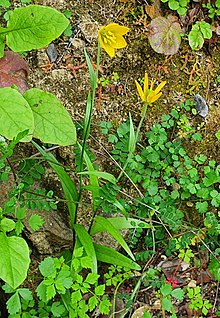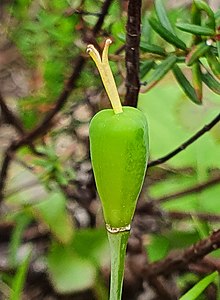Fritillaria conica
| Fritillaria conica | |
|---|---|

| |
| Fritillaria conica in situ | |
| Scientific classification | |
| Kingdom: | Plantae |
| Clade: | Tracheophytes |
| Clade: | Angiosperms |
| Clade: | Monocots |
| Order: | Liliales |
| Family: | Liliaceae |
| Subfamily: | Lilioideae |
| Tribe: | Lilieae |
| Genus: | Fritillaria |
| Species: | F. conica
|
| Binomial name | |
| Fritillaria conica | |

| |
| distribution of Fritillaria conica | |
| Synonyms[2] | |
|
Fritillaria tulipifolia Bory & Chaub. | |
Fritillaria conica is a species of flowering plant of the Liliaceae family native to South West Greece.[2] More specifically, it is endemic to the Peloponnese.

Description
Fritillaria conica is a 7-35 cm tall herb with a glabrous stem, bearing bright green, shiny, 5-8 leaves, which are not glaucous. The leaves are lanceolate to oblong-lanceolate. Basal leaves are opposite or subopposite and the upper leaves are alternate. The 1-2 terminal, conical-campanulate, flowers have a clear yellow colouration, devoid of any patterns. The flowers are nodding. After pollination, unwinged, cylindrical to subglobose capsules are formed.[3][4] They contain widely winged seeds, which are in fact one of the widest among greek species of Fritillaria.[5]
The diploid chromosome count is 2n = 24.[4]
Ecology
This species is found on rocky, limestone slopes at elevations of 350 m above sea level along with Quercus coccifera, Pistacia lentiscus and Phlomis fruticosa. Flowering occurs in March to April.[4]
Etymology
The specific epithet conica is derived from the conical shape of the flowers.
Conservation
This endangered species has small populations, which are distributed over an estimated range of 400 km². The actual area it occupies is estimated to be only 12–16 km².[6] There are only 1175 mature individuals remaining. A number, which is further declining. However, the populations are not severely fragmented and they are found at four different locations. It is threatened by agriculture and aquaculture, livestock farming and ranching. Overgrazing poses a challenge, as seed set is limited due to the destruction of flowering stalks. This species also has a low ability to reproduce vegetatively. Efforts of ex-situ conservation have been made and it is protected both under national and international legislation.[1]
References
- ^ a b Kamari, G. & Phitos, D. (2011). "Fritillaria conica". IUCN Red List of Threatened Species. 2011: e.T161962A5520345. Retrieved 13 April 2022.
- ^ a b "Fritillaria conica Boiss. | Plants of the World Online | Kew Science". powo.science.kew.org. Retrieved 13 April 2022.
- ^ Kamari, G. (1996). Fritillaria species (Liliaceae) with yellow or yellowish-green flowers in Greece. Bocconea, 5(1), 223-229.
- ^ a b c Iatrou, G. (2001). Endemic Plants of Greece. Denmark: Gad Publishers Limited.
- ^ Samaropoulou, S., Bareka, P., Bouranis, D. L., & Kamari, G. (2019). Seed morphology in the genus Fritillaria (Liliaceae) from Greece and its taxonomic significance. Phytotaxa, 416(4), 223-237.
- ^ Cunningham, A. B., Brinckmann, J. A., Pei, S. J., Luo, P., Schippmann, U., Long, X., & Bi, Y. F. (2018). High altitude species, high profits: can the trade in wild harvested Fritillaria cirrhosa (Liliaceae) be sustained?. Journal of ethnopharmacology, 223, 142-151.

